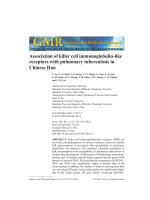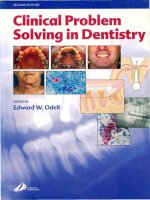Implants in Clinical Dentistry pdf
Bạn đang xem bản rút gọn của tài liệu. Xem và tải ngay bản đầy đủ của tài liệu tại đây (10.44 MB, 284 trang )
Implants in Clinical Dentistry
Implants in Clinical
Dentistry
Richard M Palmer PhD, BDS, FDS, RCS (Eng), FDS RCS (Ed)
Professor of Implant Dentistry and Periodontology,
Guy’s, Kings and St Thomas’ Hospitals Medical and Dental Schools,
London, SE1 9RT, UK
Brian J Smith BDS, MSc, FDS RCS (Eng)
Consultant in Restorative Dentistry, Unit of Restorative Dentistry,
Guy’s and St Thomas’ Hospitals Trust, London, SE1 9RT, UK
Leslie C Howe BDS, FDS RCS (Eng)
Consultant in Restorative Dentistry, Guy’s and St Thomas’ Hospitals Trusts
and Specialist in Restorative Dentistry and Prosthodontics,
21 Wimpole Street, London W1M 7AD, UK
Paul J Palmer BDS, MSc, MRD RCS (Eng)
Specialist in Periodontics, 21 Wimpole Street, London W1M 7AD and
Postgraduate Tutor in Implant Surgery, Guy’s, Kings and St Thomas’
Hospitals Medical and Dental Schools,
London, SE1 9RT, UK
MARTIN DUNITZPreface vii
Acknowledgements ix
Part I—Overview
1 Overview of implant dentistry 3
Part II—Planning
2 Treatment planning: general considerations 27
3 Single tooth planning in the anterior region 35
4 Single tooth planning for molar replacements 47
5 Fixed bridge planning 53
6 Diagnosis and treatment planning for implant dentures 69
Part III—Surgery
7 Basic factors in implant surgery 85
8 Flap design for implant surgery 97
9 Surgical placement of the single tooth implant in the anterior maxilla 105
10 Implant placement for fixed bridgework 115
11 Immediate and early replacement implants 123
12 Grafting procedures for implant placement 131
Part IV—Prosthodontics
13 Single tooth implant prosthodontics 157
14 Fixed bridge prosthodontics 183
15 Implant denture prosthodontics 215
Part V—Complications and Maintenance
16 Single tooth and fixed bridge 235
17 Implant dentures 251
Index 263
CONTENTS
vi CONTENTS
This book is based upon our combined experi-
ences of working together in the treatment of
patients with dental implant prostheses at Guy's
Hospital and in private practice over the last 10
years. While the chapters are not attributed to
specific authors, the surgical chapters are mainly
the work of Richard and Paul Palmer; the implant
denture chapters, Brian Smith; and the fixed
prosthodontics, Leslie Howe. Our initial experi-
ences were with the Brånemark system, which
established a benchmark in implant treatment,
with high success rates using meticulous tech-
niques. It was immensely valuable to use this
system at a time when it rapidly developed to
allow sophisticated treatment of the complete
clinical spectrum. Working in an academic institute
we felt that it was essential to gain experience in
other leading implant systems to allow compari-
son and to educate ourselves and our students.
We were thus able to appreciate some of the
features of other systems such as single stage
implant surgery and the development of implant
surfaces which gave the potential for more rapid
osseointegration and earlier loading. We were also
one of the initial teams to evaluate the Astra Tech
ST implant. We believe that the four implant
systems (Astra Tech, Brånemark/Nobel Biocare,
Frialit and ITI Straumann) described in this book
cover most of the important features of modern
implant design and that the information contained
within this text could apply to many more systems
that are available today.
Richard M Palmer
PhD, BDS, FDS RCS(Eng), FDS RCS(Ed)
Brian J Smith
BDS, MSc, FDS RCS(Eng)
Leslie C Howe
BDS, FDS RCS(Eng)
Paul J Palmer
BDS, MSc, MRD RCS(Eng)
PREFACE
publishers:
Dr David Radford for producing the scanning
electron microscopy images in figures 1.9, 1.10
and 1.11.
Dr Michael Fenlon for help with the case illus-
trated in figure 5.5.
Dr Claire Morgan for providing figure 15.19.
Dr Paul Robinson for help with the maxillofacial
surgical aspects of treatment in the case illus-
trated in figure 12.14.
The UK subsidiaries of Astra Tech, Frialit, Nobel
Biocare and ITI Straumann for providing illustra-
tions of some components illustrated in chapter
1.
Munksgaard International Publishers Ltd, Copen-
hagen, Denmark, for permission to reproduce
figure 1.24 which was taken from Cawood JI and
Howell RA, International Journal of Oral and
Maxillofacial Surgery, 20:75, 1991.
The British Dental Journal and Macmillan
Publishers for permission to reproduce figures
2.1, 2.4, 5.7, 5.20 and 10.1 from A Clinical Guide
to Implants in Dentistry (ed RM Palmer).
Image Diagnostic Technology, London, UK for
Figures 5.8, 5.9 and 5.10.
The highly skilled technical staff at Guy's Hospi-
tal, Kedge and Quince London W1 and Brooker
and Hamill, London W1.
ACKNOWLEDGEMENTS
Overview
Introduction
The development of endosseous osseointegrated
dental implants has been very rapid over the last
two decades and there are now many implant
systems available that will provide the clinician
with:
• a high degree of predictability in the attain-
ment of osseointegration
• versatile surgical and prosthodontic protocols
• design features that facilitate ease of treat-
ment and aesthetics
• a low complication rate and ease of mainte-
nance
• published papers to support the manufactur-
ers’ claims
• a reputable company with good customer
support
There is no perfect system and the choice may
be bewildering. It is easy for a clinician to be
seduced into believing that a new system is
better or less expensive. All implant treatment
depends upon a high level of clinical training and
experience. Much of the cost of treatment is not
system dependent but relates to clinical time and
laboratory expenses.
There are a number of published versions of
what constitutes a successful implant or implant
system. For example, Albrektsson et al. (1986)
proposed the following criteria for minimum
success:
1. An individual, unattached implant is immobile
when tested clinically.
2. Radiographic examination does not reveal
any peri-implant radiolucency.
3. After the first year in function, radiographic
vertical bone loss is less than 0.2 mm per
annum.
4. The individual implant performance is charac-
terized by an absence of signs and symptoms
such as pain, infections, neuropathies, paraes-
thesia, or violation of the inferior dental canal.
5. As a minimum, the implant should fulfil the
above criteria with a success rate of 85% at
the end of a 5-year observation period and
80% at the end of a 10-year period.
The most definitive criterion is that the implant
is not mobile (criterion 1). By definition, osseoin-
tegration produces a direct structural and
functional union between the surrounding bone
and the surface of the implant. The implant is
therefore held rigidly within bone without an
intervening fibrous encapsulation (or periodontal
ligament) and therefore should not exhibit any
mobility or peri-implant radiolucency (criterion
2). However, in order to test the mobility of an
implant supporting a fixed bridge reconstruction,
the bridge has to be removed. This fact has
limited the use of this test in clinical practice and
in many long-term studies. Radiographic bone
levels are also difficult to assess because they
depend upon longitudinal measurements from a
specified landmark. The landmark may differ
with various designs of implant and is more diffi-
cult to visualize in some than others. For
example, the flat top of the implant in the
Brånemark system is easily defined on a well-
aligned radiograph and is used as the landmark
to measure bone changes. In most designs of
implant, some bone remodelling is expected in
the first year of function in response to occlusal
forces and establishment of the normal dimen-
sions of the peri-implant soft tissues. Subse-
quently the bone levels are usually stable on the
majority of implants over many years. A small
proportion of implants may show some bone
loss and account for the mean figures of bone
loss that are published in the literature.
1
Overview of implant dentistry
Progressive or continuous bone loss is a sign of
potential implant failure. However, it is difficult
or impossible to establish agreement between
researchers/clinicians as to what level of bone
destruction constitutes failure, therefore most
implants described as failures are those that
have been removed from the mouth. Implants
that remain in function but do not match the
criteria for success are described as ‘surviving’.
Implants placed in the mandible (particularly
anterior to the mental foramina) enjoy a very
high success rate, such that it would be difficult
or impossible to show differences between rival
systems. In contrast, the more demanding situa-
tion of the posterior maxilla, where implants of
shorter length are placed in bone of softer
quality, may reveal differences between success
rates. This remains to be substantiated in
comparative clinical trials. Currently there are no
comparative data to recommend one system
over another, but certain design features may
have theoretical advantages (see section on
implant design).
Patient factors
There are few contraindications to implant treat-
ment. The main potential problem areas to
consider are:
• Age
• Untreated dental disease
• Severe mucosal lesions
• Tobacco smoking, alcohol and drug abuse
• Poor bone quality
• Previous radiotherapy to the jaws
• Poorly controlled systemic disease such as
diabetes
• Bleeding disorders
Age
The fact that the implant behaves as an
ankylosed unit restricts its use to individuals who
have completed their jaw growth. Placement of
an osseointegrated implant in a child will result
in relative submergence of the implant restora-
tion with growth of the surrounding alveolar
process during normal development. It is there-
fore advisable to delay implant placement until
growth is complete, this is generally earlier in
females than males, but considerable variation
exists. It is usually acceptable to treat patients in
their late teens. Although some growth potential
may remain in patients in their early twenties,
this is less likely to result in an aesthetic
problem.
There is no upper age limit to implant treat-
ment provided that the patient is fit enough and
willing to be treated. For example, elderly
edentulous individuals can experience consider-
able quality of life and health gain with implant
treatment to stabilize complete dentures (see
Chapter 6).
Untreated dental disease
The clinician should ensure that all patients are
comprehensively examined, diagnosed and
treated to deal adequately with concurrent dental
disease.
Severe mucosal lesions
Caution should be exercised before treating
patients with severe mucosal/gingival lesions
such as erosive lichen planus or mucous
membrane pemphigoid. When these conditions
affect the gingiva they are often more problem-
atic around the natural dentition and the discom-
fort compromises plaque control, adding to the
inflammation. Similar lesions can arise around
implants penetrating the mucosa.
Tobacco smoking and drug abuse
It is well established that tobacco smoking is a
very important risk factor in periodontitis and
that it affects healing. This has been demon-
strated extensively in the dental, medical and
surgical literature. A few studies have shown that
the overall mean failure rate of dental implants
in smokers is approximately twice that in non-
smokers. Smokers should be warned of this
4 IMPLANTS IN CLINICAL DENTISTRY
association and encouraged to quit the habit.
Protocols have been proposed that recommend
smokers to give up for at least two weeks prior
to implant placement and for several weeks
afterwards. Such recommendations have not
been tested adequately in clinical trials and nor
has the compliance of the patients. The chance
of the quitter relapsing is disappointingly high
and some patients will try to hide the fact that
they are still smoking. It should also be noted
that reported mean implant failure rates are not
evenly distributed throughout the patient popula-
tion. Rather, implant failures are more likely to
cluster in certain individuals. In our experience
this is more likely in heavy smokers who have a
high intake of alcohol. In addition, failure is more
likely in those who have poor-quality bone,
which is a possible association with tobacco
smoking. It should be noted also that smokers
followed in longitudinal studies have been
shown to have more significant marginal bone
loss around their implants than non-smokers.
Most of these findings have been reported from
studies involving the Brånemark system, proba-
bly because it is one of the best-documented and
widely used systems to date. More data involv-
ing other systems would be useful.
Drug abuse may affect the general health of
individuals and their compliance with treatment
and may therefore be an important contraindica-
tion.
Poor bone quality
This is a term often used to denote regions of
bone in which there is low mineralization or poor
trabeculation. It is often associated with a thin or
absent cortex and is referred to as type 4 bone
(see section on bone factors). It is a normal variant
of bone quality and is more likely to occur in the
posterior maxilla. Osteoporosis is a condition that
results in a reduction of the bone mineral density
and commonly affects postmenopausal females,
having its greatest effect in the spine and pelvis.
The commonly used DEXA (Dual Energy X-Ray
Absorptiometry) scans for osteoporosis assess-
ment do not generally provide useful clinical
measures of the jaws. The effect of osteoporosis
on the maxilla and mandible may be of little
significance in the majority of patients. Many
patients can have type 4 bone quality, particularly
in the posterior maxilla, in the absence of any
osteoporotic changes.
Previous radiotherapy to the jaws
Radiation for malignant disease of the jaws
results in endarteritis, which compromises bone
healing and in extreme cases can lead to osteo-
radionecrosis following trauma/infection. These
patients requiring implant treatment should be
managed in specialist centres. It can be helpful
to optimize timing of implant placement in
relation to the radiotherapy and to provide a
course of hyperbaric oxygen treatment. The
latter may improve implant success particularly
in the maxilla. Success rates in the mandible
may be acceptable even without hyperbaric
oxygen treatment, although more clinical trials
are required to establish the effectiveness of the
recommended protocols.
Poorly controlled systemic disease
such as diabetes
Diabetes has been a commonly quoted factor to
consider in implant treatment. It does affect the
vasculature, healing and response to infection.
Although there is limited evidence to suggest
higher failure of implants in well-controlled
diabetes, it would be unwise to ignore this factor
in poorly controlled patients.
Bleeding disorders
Bleeding disorders are obviously relevant to the
surgical delivery of treatment and require advice
from the patient’s physician.
Osseointegration
Osseointegration is basically a union between
bone and the implant surface (Figure 1.1). It is
not an absolute phenomenon and can be
OVERVIEW OF IMPLANT DENTISTRY 5
measured histologically as the proportion of the
total implant surface that is in contact with bone.
Greater levels of bone contact occur in cortical
bone than in cancellous bone, where marrow
spaces are often adjacent to the implant surface.
Therefore bone with well-formed cortices and
dense trabeculation offers the greatest potential
for a high degree of bone to implant contact. The
degree of bone contact may increase with time.
The precise nature of osseointegration at a
molecular level is not fully understood. At the
light microscope level there is a very close
adaptation of the bone to the implant surface. At
the higher magnifications possible with electron
microscopy, there is a gap (approximately
100 nm wide) between the implant surface and
the bone. This is occupied by an intervening
collagen-rich zone adjacent to the bone and a
more amorphous zone adjacent to the implant
surface. Bone proteoglycans may be important in
the initial attachment of the tissues to the
implant surface, which in the case of titanium
implants consists of a titanium oxide layer,
which is defined as a ceramic.
6 IMPLANTS IN CLINICAL DENTISTRY
Figure 1.1
(A) Histological section of osseointegration. At the light microscope level the bone appears to be in intimate contact with
the titanium implant surface over a large proportion of the area. Small marrow spaces are visible where bone is not in
contact with the implant surface. (B) Higher power micrograph showing almost total bone to implant contact.
A B
It has been proposed that the biological
process leading to and maintaining osseointe-
gration is dependent upon the following factors,
which will be considered in more detail in the
subsequent sections:
• Biocompatibility
• Implant design
• Submerged and non-submerged protocols
• Bone factors
• Loading conditions
• Prosthetic loading considerations
Biocompatibility
Most current dental implants (including all
systems considered in this book) are made of
commercially pure titanium. Titanium has estab-
lished a benchmark in osseointegration against
which few other materials compare. Related
materials such as niobium are able to produce a
high degree of osseointegration and, in addition,
successful clinical results are reported with
titanium–aluminium–vanadium alloys. The titan-
ium alloys have the potential disadvantage of
ionic leakage of aluminium into the tissues but
they have the potential to enhance the physi-
cal/mechanical properties of the implants. This
would be of greater significance in narrow-
diameter implants.
Hydroxyapatite-coated implants have the
potential to allow more rapid bone growth on
their surfaces and they have been recommended
for use in situations of poorer bone quality. The
reported disadvantages are delamination of the
coating and corrosion with time. More recently,
resorbable coatings have been developed that
aim to improve the initial rate of bone healing
against the implant surface, followed by resorp-
tion within a short time frame to allow estab-
lishment of a bone to metal contact. Hydroxy-
apatite-coated implants are not considered
within this book because the authors have no
experience of them.
All the implant systems used by the authors
and illustrated in this book are made from
titanium and therefore are highly comparable in
this respect. The main differences in the systems
are in the design, which is considered in the next
section.
Implant design
Implant design usually refers to the design of the
intraosseous component (the endosseous dental
implant). However, the design of the implant
abutment junction and the abutments is ex-
tremely important in prosthodontic management
and maintenance and will be dealt with in a
separate section.
The implant design has a great influence on
initial stability and subsequent function in bone.
The main design parameters are:
• Implant length
• Implant diameter
• Implant shape
• Surface characteristics
Implant length
Implants are generally available in lengths from
about 6 mm to as much as 20 mm. The most
common lengths employed are between 8 and 15
mm, which correspond quite closely to normal
root lengths. There has been a tendency to use
longer implants in systems such as Brånemark
compared with, for example, Straumann. The
Brånemark protocol advocated maximizing
implant length, where possible, to engage bone
cortices apically as well as marginally in order to
gain high initial stability. In contrast, the concept
with Straumann was to increase the surface area
of shorter implants by design features (e.g.
hollow cylinders) or surface treatments (see
section on surface characteristics).
Implant diameter
Most implants are approximately 4 mm in
diameter. A diameter of at least 3.25 mm is
recommended to ensure adequate implant
strength. Diameters up to 6.5 mm are available,
which are considerably stronger and have a
much higher surface area. They may also engage
lateral bone cortices to enhance initial stability.
However, they may not be so widely used
because sufficient bone width is not commonly
encountered in most patients’ jaws.
OVERVIEW OF IMPLANT DENTISTRY 7
Implant shape
Various shapes are used by different manufac-
turers:
• Brånemark implants are solid screws (3.3, 3.75,
4, 5 or 5.5 mm in diameter) with a thread pitch
of 0.6 mm (Figures 1.2 and 1.3). The implants
can be self-tapped owing to the fact that they
have a cutting end. The original design of the
Brånemark implant was not a self-tapper, and
in good-quality bone the implant site needed
to be tapped prior to implant insertion. In
softer bone (type 4 and possibly type 3) the
implant will develop its own thread passage
without prior tapping. The original design (and
protocol) is preferred by the authors even
though it may be slightly more time consum-
ing. This is because the self-tapper design has
quite pronounced cutting flutes that do not
allow as smooth an entry into the bone site
(This feature has been improved in the latest
Mark 3 design: Nobel Biocare AB, Göteborg,
Sweden; Figure 1.2.) Pre-tapping ensures that
the implant will readily seat to the desired
level. If self-tapping implants are used in dense
bone, the site may have to be made wider with
a larger diameter twist drill (or pre-tapped as
in the original protocol).
• AstraTech implants are parallel-sided self-
tapping solid screws (basically 3.5 mm or
4 mm in diameter) with a thread pitch of
0.6 mm (Figure 1.4). To allow for successful
seating of the implant, the bone preparation
is made with twist drills 0.3 mm less in diame-
ter in normal quality bone and 0.15 mm
narrower in hard or dense bone. The single
tooth (ST: Astra Meditec AB, Mölndal,
8 IMPLANTS IN CLINICAL DENTISTRY
Figure 1.2
The latest design of Nobel Biocare implant (based on the
original Brånemark concept) has a self-tapping end. The
standard implants are 3.75 mm in diameter and available
in a range of lengths from 7 to 20 mm.
Figure 1.3
A narrow-diameter (3.3 mm) Nobel Biocare implant being
installed in a narrow maxillary lateral incisor space.
Figure 1.4
AstraTech implants showing the various diameters and
designs available. The standard implants of 3.5 and
4.0 mm are on the left and the single tooth (ST) implants
on the right. The ST implants have identical bodies to the
standard implants but have a microthreaded conical collar
that houses an internal anti-rotational double-hexagon
element.
Sweden) implant has a different design in that
the top part has a microthreaded conical
collar, which is claimed to distribute stress at
the marginal bone more favourably.
• Straumann implants used to be available as
hollow screws, hollow cylinders or solid
screws. The hollow cylinders greatly increase
the available surface area for bone contact but
are now only available in a pre-angled design
OVERVIEW OF IMPLANT DENTISTRY 9
Figure 1.5
An angled hollow-cylinder
Straumann implant specifi-
cally recommended for
anterior maxillary single
tooth replacement. This
implant has a titanium-
plasma-sprayed surface.
Figure 1.6
A 4.1-mm diameter solid-
screw Straumann implant.
This particular implant is an
aesthetic line implant that
has a reduced height of
polished collar (1.8 mm, as
opposed to 2.8 mm on the
standard implant). The
surface has been sand-
blasted and acid etched.
The top of the polished
collar expands to a diameter
of 4.8 mm.
Figure 1.7
The Frialit 2 implants are stepped cylinders and therefore
are more like tapered root forms. The implant on the right
has threads on each of the steps and is recommended
where greater stability at placement is required, such as
immediate placement into extraction sockets.
Figure 1.8
The matched drills for the stepped Frialit 2 implants, with
lengths of 11, 13 and 15 mm and diameters of 3.8, 4.5,
5.5 and 6.5 mm.
for single anterior tooth replacement (Figure
1.5). Hollow screws are no longer available (a
higher rate of fracture was observed in hollow
designs). The solid screws are the only design
used by the authors (Figure 1.6). They are
available in diameters of 3.2, 4.1 and 4.8 mm
and have a coarse-thread pitch.
• Frialit implants (Figures 1.7 and 1.8) are
tapered, stepped cylinders (3.8, 4.5, 5.5 and
6.5 mm diameter at the top). They are there-
fore more ‘root form’, with the various diame-
ters designed to replace teeth of corres-
ponding dimensions. Most implants of this
design are pushed or tapped into place. An
alternative design has self-tapping threads on
the steps, which requires that the implant is
given three rotations to seat it.
Surface characteristics
The degree of surface roughness varies greatly
between different systems. Surfaces that are
machined, grit-blasted, plasma sprayed and
coated are available:
• Brånemark implants have a machined surface
as a result of the cutting of the screw thread.
This has small ridges when viewed at high
magnification (Figure 1.9) and this degree of
surface irregularity was claimed to be close to
ideal because smoother surfaces fail to
osseointegrate and rougher surfaces are more
prone to ion release and corrosion. This claim
is disputed and the other implants listed below
have rougher surfaces that may favour osseoin-
tegration. The 3i implants that were based on
the Brånemark design are available with an
acid-etched surface on the threads apical to the
first 2 mm. Brånemark implants are now also
available with a treated surface (TiUnite).
• AstraTech implants have a roughened surface
produced by ‘grit blasting’, in this case with
titanium oxide particles. The resulting surface
has approximately 5-µm depressions over the
entire intraosseous part of the implant. This
surface has been termed ‘TiO blasted’ (Figure
1.10). Comparative tests in experimental
animals have demonstrated a higher degree
of bone to implant contact and higher torque
removal forces than machined surfaces.
• Straumann – surfaces were originally plasma
sprayed (Figure 1.11). Molten titanium is
sprayed onto the surface of the implant to
produce a rougher surface than a blasted one.
The available surface area is much larger and
this may have advantages in lower quality
bone and enhanced performance of short
(under 10 mm) implants. Straumann have
developed a newer surface called the SLA
(Sand blasted–Large grit–Acid etched: Institut
Straumann AG, Waldenburg, Switzerland;
Figure 1.12). This surface has large irregular-
ities with smaller ones superimposed on top.
It is claimed to have an advantage over the
plasma-sprayed surface, with a reduction in
healing time to achieve osseointegration. All
Straumann implants have a highly polished
collar (2.8 mm long in the standard implant)
to allow soft-tissue adaptation because they
were originally designed as a non-submerged
system (see section on submerged and non-
submerged protocols).
10 IMPLANTS IN CLINICAL DENTISTRY
Figure 1.9
Electron micrograph of a ‘machined’ implant surface.
There are ridges and grooves produced during the machin-
ing. The macroscopic appearance can be seen in Figures
1.2 and 1.3.
OVERVIEW OF IMPLANT DENTISTRY 11
Figure 1.10
(A) AstraTech TiO-blasted surface. This scanning electron
micrograph shows the numerous pits of approximately
5µm.
Figure 1.10
(B) Lower power view showing the TiO-blasted surface on
the thread profiles.
A
B
Figure 1.11
Scanning electron micrograph of the Straumann plasma-
sprayed surface at the junction with the polished collar
(top).
Figure 1.12
(A) The Straumann SLA surface produces a complex of
large and small pits providing a large area for osseointe-
gration.
A
• Frialit – implants are available in both plasma-
sprayed surfaces and acid-etched and grit-
blasted/acid-etched surfaces (Figures 1.12 and
1.13). The top collar is polished to allow soft
tissue adaptation.
The optimum surface morphology has yet to
be defined, and some may perform better in
some circumstances. By increasing the surface
roughness there is the potential to increase the
surface contact with bone, but this may be at the
expense of more ionic exchange and surface
corrosion. Bacterial contamination of the implant
surface also will be affected by the surface
roughness if it becomes exposed within the
mouth. The current trend is therefore towards
slightly roughened surfaces (blasted/etched).
Implant/abutment design
Most implant systems have a wide range of
abutments for various applications (e.g. single
tooth, fixed bridge, overdenture) and techniques
(e.g. standard manufactured abutments,
prepable abutments, cast-to abutments; see
Chapters 13 and 14). However, the design of the
implant abutment junction varies considerably:
• Brånemark – this junction is described as a
flat-top external hexagon (Figure 1.14). The
hexagon was designed to allow rotation (i.e.
screwing-in) of the implant during placement.
It is an essential design feature in single tooth
(ST) replacement as an anti-rotational device.
The design proved to be very useful in the
development of direct recording of impres-
sions of the implant head rather than the
abutment, thus allowing evaluation and
abutment selection in the laboratory (see
Chapter 13). The abutment is secured to the
implant with an abutment screw. The joint
between implant and abutment is precise but
does not produce a seal, a feature that does
not appear to result in any clinical disadvan-
tage. The hexagon is only 0.6 mm high and it
may be difficult for the inexperienced clinician
to determine whether the abutment is
precisely located on the implant. The fit is
therefore normally checked radiographically,
which also requires a good paralleling
technique for adequate visualization of the
joint. Similar designs of external hexagon
implants have increased the height of the
hexagon to 1 mm, making abutment connec-
tion easier. However, newer abutment designs
for multiple-connected units (which do not
require an anti-rotational property) have
abandoned the female part of the hexagon to
allow easier connection and avoid problems of
malalignment (Nobel Biocare multi-unit
abutment). The original design concept was
that the weakest component of the system
was the small gold screw (prosthetic screw)
that secured the prosthesis framework to the
abutment, followed by the abutment screw
12 IMPLANTS IN CLINICAL DENTISTRY
Figure 1.12
(B) Scanning electron micrograph of the Frialit grit-blasted
and acid-etched surface.
Figure 1.13
Scanning electron micrograph of the acid-etched surface
in the Frialit system.
B
and then the implant (Figure 1.15). Thus,
overloads leading to component failure should
be dealt with more readily (see Chapter 16).
• AstraTech – this design incorporates a conical
abutment fitting into the conical head of the
implant, described by the manufacturers as a
‘conical seal’ (Figure 1.16). The taper of the
cone is 11°, which is greater than a morse
taper (6°). The abutments self-guide into
position and are easily placed even in very
difficult locations. It is not usually necessary
to check the localization with radiographs.
This design produces a very secure, strong
union. The standard abutments are solid one-
piece components, whereas the ST abutments
and customizable abutments are two-piece
with an abutment screw. The ST implant and
abutments feature an internal hexagon anti-
rotation design (Figure 1.17).
• Straumann – this implant has a transmucosal
collar, a feature that many of the other sys-
tems incorporate in the abutment design. The
abutment/implant junction is therefore often
supramucosal and the connection and check-
OVERVIEW OF IMPLANT DENTISTRY 13
Figure 1.14
The external hexagon at the top of the Brånemark implant
shown here immediately after implant placement. The
hexagon was originally used to rotate the implant into
place, but Nobel Biocare have recently developed a new
inserting mechanism within the internal thread.
Figure 1.15
A section through the ‘original’ Brånemark implant stack.
At the top, a small gold screw secures the prosthetic gold
cylinder to the abutment screw, which in turn holds the
abutment onto the implant.
Figure 1.16
Section through an AstraTech stack showing a very good
fit between the abutment and the implant. The interface
is an internal cone with an angle of 11°.
ing of the fit of the components are easier
than most systems. The aesthetic line implant
has a shorter collar (1.8 mm) to allow submu-
cosal placement of the abutment/prosthesis
union but the connection is still easy due to
the internal tapered conical design with an
angle of 8° (Figure 1.18).
• Frialit – this has some of the features of the
previously described systems. Basically, the
abutment fits within the implant head but is
parallel sided (Figures 1.19 and 1.20). It
features an internal hexagon anti-rotational
system and an abutment screw, which also
secures the prosthesis in screw-retained fixed
bridge designs. The junction seal is improved
with a silicone washer within the assembly
(not to be confused with the intra-mobile
element of the IMZ system, which is not
considered in this book).
Submerged and non-submerged
protocols
The terms submerged and non-submerged
implant protocols were at one time clearly appli-
cable to different implant systems. The classic
submerged system was the original protocol as
described by Brånemark. Implants were installed
with the head of the implant (and cover-screw)
level with the crestal bone and the muco-
14 IMPLANTS IN CLINICAL DENTISTRY
Figure 1.17
A selection of AstraTech single tooth (ST) abutments of
various lengths. The lower part shows the anti-rotational
hexagon which fits within the collar of the ST implant. The
conical sides of the abutment fit within the internal cone
of the implant head. The top part has an octagonal anti-
rotation design to accept the ST crown.
Figure 1.18
The left ‘cut-away’ picture shows the head of the standard
solid-screw Straumann implant, featuring an internal
conical design (and anti-rotational grooves) that allows a
very precise fit with the solid abutments shown on the
right.
Figure 1.19
The internal hexagon of the Frialit 2 (Friatec AG,
Mannheim, Germany) implant. The abutments are shown
in Figure 1.20.
Figure 1.20
Frialit 2 abutments showing the hexagons that engage the
‘hex’ in the implant head.









